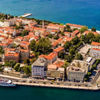
The garden island


Green where the eye looks
Madeira’s inhabitants are avid gardeners. Besides relaxing in parks and cultivating lush private gardens, they are also dedicated to reviving their primeval forests.


«A trabalhar!»
It is an early Saturday morning, but the sun is already blazing down on the Pico do Arieiro, Madeira’s third-highest mountain that rises to 5965 feet. About thirty men, women and children, are at work on the mountain’s barren slopes. The volunteers are busy digging and hacking holes into the rocky terrain, where they will plant ragged seedlings and water them, and then surround them with protective stones. “We will keep on until we have transformed the mountain desert into an oasis,” Raimundo Quintal explains. The geographer with a PhD is omnipresent, giving advice and pitching in.

Barren mountain landscape
The barren vegetation of Madeira’s mountains is the result of centuries of misuse. When Portuguese seafarers took possession of the then uninhabited island in 1419, it was covered in primeval forest – thus the name "Madeira", which is Portuguese for "wood". And then the discoverers lit fires to clear the forests, to create fields in their stead. If some sources are to be believed, the fires burned for seven years. The colonists used the hardest woods to build ships and houses.


Island of eternal spring
Lunch break! The kitchen team hands out thick slices of white bread with hard cheese and "uva-da-serra" (blueberry) marmalade. Meanwhile, Raimundo Quintal allows himself to be chauffeured down the serpentine road to the valley – to the other Madeira: flowering Madeira. So this is it, the opulent picture-book island that adorns itself with sobriquets like "Flower of the Ocean" and "Island of Eternal Spring". Two thirds of the island are natural conservation areas.


Mother of the Levada
It ripples in streams down the steep slopes and tumbles vociferously in a waterfall into a moss-bedecked rock amphitheater. Stone walls capture the water and redirect it to mini-canals. “This is the mother of the Levada,” says Raimundo Quintal. The canals, known as "Levadas", were laid to deliver water to the dry south of the island. Today, Madeira’s irrigation system encompasses more than 1250 miles of these waterways. The "Levadeiros" see to it that every farmer and every gardener receives his share of water.

Flower gardens
Clinging to the slopes below the forest there are farmhouses. Their front gardens are awash with richly coloured roses, lilies and birds of paradise. The ground is covered in a carpet of fallen azalea flowers that crunch quietly under one’s feet. "Our gardens are our business cards,” Raimundo Quintal explains. "We Madeirans have always had green fingers."

Botanical garden
One of the loveliest gardens is located in the capital of Funchal on the premises of the “Quinta do Bom Sucesso”, which became the site of the Madeira Botanical Gardens in 1960. Crowds of visitors admire the biodiversity of the gardens that are home to araucarias from Chile, aloes from South Africa, camellias from Asia, redwoods from North America, kauris from New Zealand and jacarandas from Brazil. Over the course of the centuries, mariners and immigrants brought the seedlings to the island from all over the world.

This holiday tip was presented to you by our cooperation partner:
Header - Photo by Oliver Gerhard
Paragraph 2 - Photo by Henrique Seruca from visitmadeira.pt
Paragraph 2 - Photo by Henrique Seruca from visitmadeira.pt
Paragraph 2 - Photo owned by Edelweiss
Paragraph 3 - Photo by Lili Kovac on Unsplash
Paragraph 4 - Photos by Henrique Seruca from visitmadeira.pt
Paragraph 5 - Photos by Oliver Gerhard Oliver Gerhard
Paragraph 6 - Photo by Oliver Gerhard
Paragraph 7 - Photos by Andre Carvalho from visitmadeira.pt











